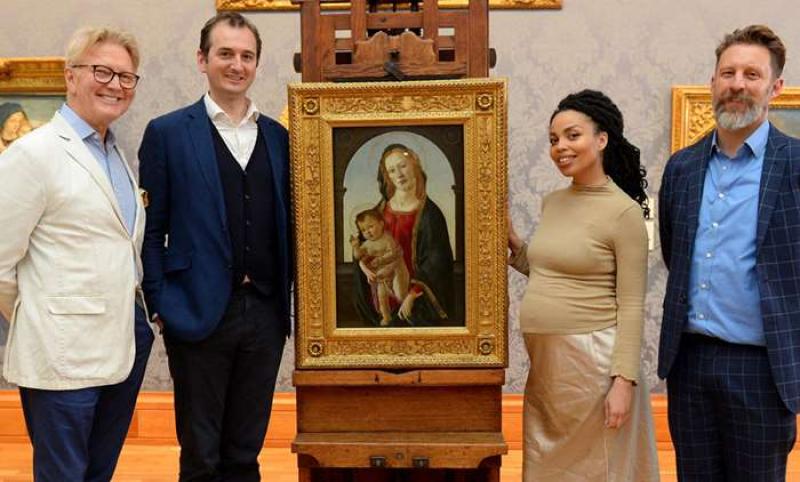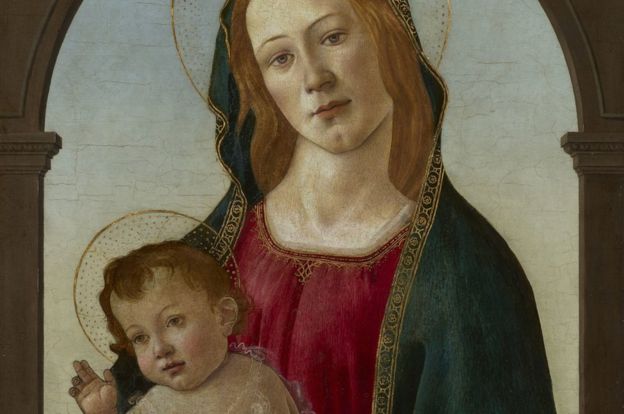Britain’s Lost Masterpieces, Episode Three, BBC Four review – more than a bit of Botticelli | reviews, news & interviews
Britain’s Lost Masterpieces, Episode Three, BBC Four review – more than a bit of Botticelli
Britain’s Lost Masterpieces, Episode Three, BBC Four review – more than a bit of Botticelli
A hidden Renaissance gem in Cardiff Art Gallery

Once again the whodunit becomes the whoforgedit in the newest installment of the Britain’s Lost Masterpieces series.
Social historian Emma Dabiri delves into the background of the work’s previous owner, the wealthy Gwendoline Davies, who bequeathed it to Cardiff Art Gallery in 1952. Davies believed the work to be an original Botticelli after their dealer had upgraded it from being merely “in the studio of Botticelli”. The Gallery downgraded the work following the gifting, but questions always lingered.
To try and fill gaps, Grosvenor takes us to Florence to understand the shady deception of the Medici era. After the Pope tried to sabotage Medici rule, the young Botticelli was sent to Rome to work on, amongst other projects, the Sistene Chapel. Upon returning to Florence after many years, Botticelli founded his own studio. It was here that the Madonna with Child would have been painted.
 Conservator Simon Gillespie is brought in to restore the painting. Along the way, he pries out details that widen the detective trail. Some of the cracks in the paint had been faked, suggesting a retouching by subsequent owners. This does not wholly discredit the work’s authenticity. Infrared and X-ray photographs confirm that some of the paint was applied in the style of Botticelli’s studio, and the poplar wood is the type that would have been used in Florence at the time.
Conservator Simon Gillespie is brought in to restore the painting. Along the way, he pries out details that widen the detective trail. Some of the cracks in the paint had been faked, suggesting a retouching by subsequent owners. This does not wholly discredit the work’s authenticity. Infrared and X-ray photographs confirm that some of the paint was applied in the style of Botticelli’s studio, and the poplar wood is the type that would have been used in Florence at the time.
This episode does well to introduce a touch of satire to the stupendous reverence. Grosvenor gushes endlessly over the beauty of the Madonna, only to have Dabiri accuse him of male voyeurism. Art dealers and connoisseurs – “sages” to some – are exposed as cunning status-hungry tricksters. One such, the American Bernard Berenson, would be heftily rewarded by his patron Joseph Duveen when a genuine original was found. This only incentivised Berenson to promote fakes as originals and to exaggerate their value. The Botticelli Madonna and Child came under his gaze. But Grosvenor sees this painting as an outlier for Berenson: “something about the quality of the face caught his eye”. Berenson may have been seduced, but he also genuinely believed the work to be a Botticelli studio production.
Back in Cardiff the work is finally presented. A letter is produced from the Yale University Art Gallery’s chief curator Laurence Kanter, a Botticelli expert: “Clearly this beautiful painting came from Botticelli’s studio. Probably Botticelli himself is responsible for more than a bit of it.” Not the glorious confirmation we might’ve wanted. But it seems just enough, at least for our host, who finally manages to tone down his enchantment: “We’re quite pleased with that”.
The future of Arts Journalism
You can stop theartsdesk.com closing!
We urgently need financing to survive. Our fundraising drive has thus far raised £49,000 but we need to reach £100,000 or we will be forced to close. Please contribute here: https://gofund.me/c3f6033d
And if you can forward this information to anyone who might assist, we’d be grateful.

Subscribe to theartsdesk.com
Thank you for continuing to read our work on theartsdesk.com. For unlimited access to every article in its entirety, including our archive of more than 15,000 pieces, we're asking for £5 per month or £40 per year. We feel it's a very good deal, and hope you do too.
To take a subscription now simply click here.
And if you're looking for that extra gift for a friend or family member, why not treat them to a theartsdesk.com gift subscription?
more TV
 theartsdesk Q&A: Suranne Jones on 'Hostage', power pants and politics
The star and producer talks about taking on the role of Prime Minister, wearing high heels and living in the public eye
theartsdesk Q&A: Suranne Jones on 'Hostage', power pants and politics
The star and producer talks about taking on the role of Prime Minister, wearing high heels and living in the public eye
 King & Conqueror, BBC One review - not many kicks in 1066
Turgid medieval drama leaves viewers in the dark
King & Conqueror, BBC One review - not many kicks in 1066
Turgid medieval drama leaves viewers in the dark
 Hostage, Netflix review - entente not-too-cordiale
Suranne Jones and Julie Delpy cross swords in confused political drama
Hostage, Netflix review - entente not-too-cordiale
Suranne Jones and Julie Delpy cross swords in confused political drama
 In Flight, Channel 4 review - drugs, thugs and Bulgarian gangsters
Katherine Kelly's flight attendant is battling a sea of troubles
In Flight, Channel 4 review - drugs, thugs and Bulgarian gangsters
Katherine Kelly's flight attendant is battling a sea of troubles
 Alien: Earth, Disney+ review - was this interstellar journey really necessary?
Noah Hawley's lavish sci-fi series brings Ridley Scott's monster back home
Alien: Earth, Disney+ review - was this interstellar journey really necessary?
Noah Hawley's lavish sci-fi series brings Ridley Scott's monster back home
 The Count of Monte Cristo, U&Drama review - silly telly for the silly season
Umpteenth incarnation of the Alexandre Dumas novel is no better than it should be
The Count of Monte Cristo, U&Drama review - silly telly for the silly season
Umpteenth incarnation of the Alexandre Dumas novel is no better than it should be
 The Narrow Road to the Deep North, BBC One review - love, death and hell on the Burma railway
Richard Flanagan's prize-winning novel becomes a gruelling TV series
The Narrow Road to the Deep North, BBC One review - love, death and hell on the Burma railway
Richard Flanagan's prize-winning novel becomes a gruelling TV series
 The Waterfront, Netflix review - fish, drugs and rock'n'roll
Kevin Williamson's Carolinas crime saga makes addictive viewing
The Waterfront, Netflix review - fish, drugs and rock'n'roll
Kevin Williamson's Carolinas crime saga makes addictive viewing
 theartsdesk Q&A: writer and actor Mark Gatiss on 'Bookish'
The multi-talented performer ponders storytelling, crime and retiring to run a bookshop
theartsdesk Q&A: writer and actor Mark Gatiss on 'Bookish'
The multi-talented performer ponders storytelling, crime and retiring to run a bookshop
 Ballard, Prime Video review - there's something rotten in the LAPD
Persuasive dramatisation of Michael Connelly's female detective
Ballard, Prime Video review - there's something rotten in the LAPD
Persuasive dramatisation of Michael Connelly's female detective
 Bookish, U&Alibi review - sleuthing and skulduggery in a bomb-battered London
Mark Gatiss's crime drama mixes period atmosphere with crafty clues
Bookish, U&Alibi review - sleuthing and skulduggery in a bomb-battered London
Mark Gatiss's crime drama mixes period atmosphere with crafty clues
 Too Much, Netflix - a romcom that's oversexed, and over here
Lena Dunham's new series presents an England it's often hard to recognise
Too Much, Netflix - a romcom that's oversexed, and over here
Lena Dunham's new series presents an England it's often hard to recognise

Add comment